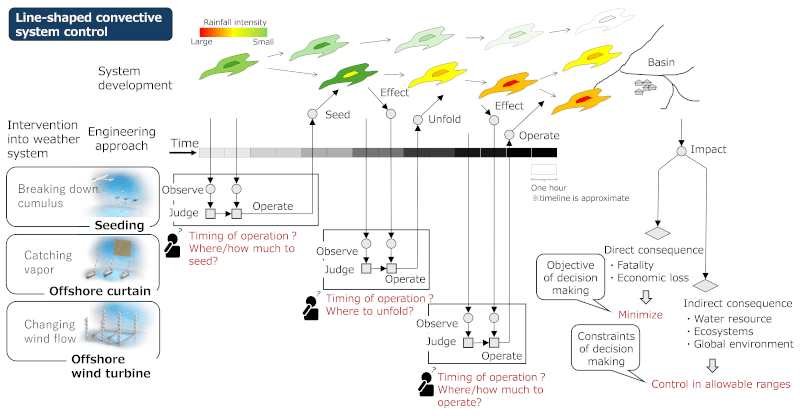Progress Report
Heavy Rainfall Control for Living Together with Isolated-Convective Rainstorms and Line-Shaped Rainbands[2] Construction of a control system
Progress until FY2024
1. Outline of the project
Develop a control system that combines observation, prediction, and decision-making to effectively suppress heavy rains by implementing multiple engineering methods at different times and stages (Fig. 1). Additionally, the control system would be designed to intervene at multiple stages to course-correct when an unexpected deviation occurs. Furthermore, our goal is to implement multiple types of interventions at various stages to increase the regulatory effect. Specifically, we aim to develop a decision-making support system that can derive optimal solutions by combining multiple control methods in real-time by (1) simplifying the time evolution model for heavy rain events and constructing an ensemble prediction method, (2) constructing monitoring methods for regulation, (3) setting appropriate objective functions based on the output of ELSI/RRI research, and (4) optimizing algorithms.

2. Outcome so far
①Formulation of a decision-making problem for heavy rainfall control
The objective of R&D Item 2 is to develop a system capable of deriving optimal solutions for operations in real time. This system integrates knowledge from Item 1 on various operational methods and from Item 3 on the evaluation of impacts on floods, water resources, and human societies (Fig. 2).
Collaborative discussions were held with Items 1, 3 to identify the four essential elements required to formulate a decision-making problem: the objective function, constraints, possible interventions, and random phenomena. The proposed engineering solutions—seeding, offshore curtain, and offshore wind turbines—were developed by considering their spatial impact on weather phenomena associated with heavy rainfall and the temporal scale from the initiation of control measures to the manifestation of their effects.
In addition, considering heavy rainfall in the northern Kyushu region, decision-making scenarios and timelines for a series of control measures, including seeding, offshore curtains, and wind turbines, were discussed. Furthermore, the GUI , execution environment, and background data processing of the real-time decision-making support system were examined, and the requirements for developing the demonstration system in the next fiscal year and beyond were organized.

②Understanding the mechanism of heavy rainfall for control
With a view to realizing weather control by 2050, a general analysis of the governing mechanisms and a basic analysis of randomness have begun to identify the physical quantities to be controlled, as well as their locations and timing, to contribute to the development of effective weather control methods. This process involves analyzing the mechanisms behind line-shaped convective system heavy rainfall and the pathways of water vapor inflow in the context of global warming.
3. Future plans
Future developments involve creating a decision-making demonstration system based on the characteristics of control methods, particularly focusing on the phenomena used to guide implementation decisions and their observation methods, the time required from decision to implementation, and the phenomena used to assess effectiveness along with their observation methods. This system will also consider the relationship between the effects of control (both direct effects of heavy rain and social effects) and the scope of the decision-making problem.